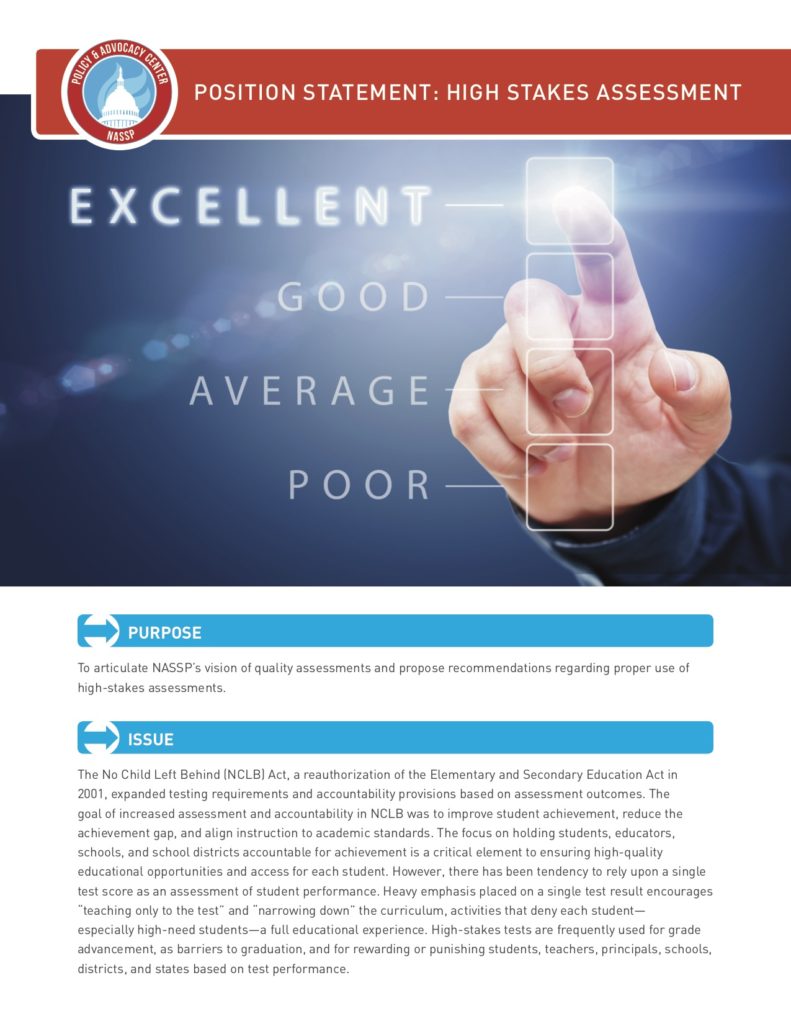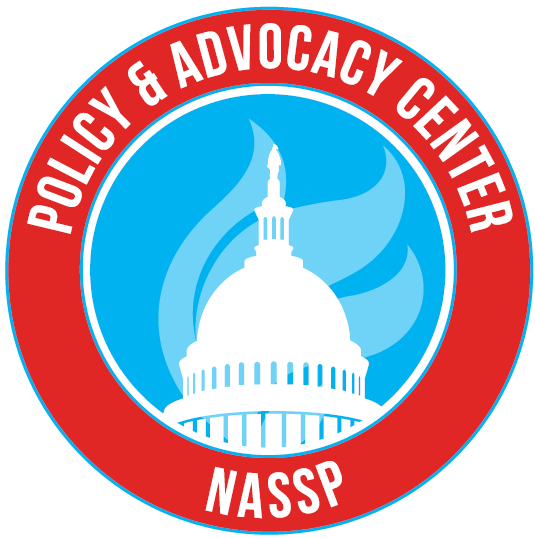To articulate NASSP’s vision of quality assessments and propose recommendations regarding proper use of high-stakes assessments.
The No Child Left Behind (NCLB) Act, a reauthorization of the Elementary and Secondary Education Act in 2001, expanded testing requirements and accountability provisions based on assessment outcomes. The goal of increased assessment and accountability in NCLB was to improve student achievement, reduce the achievement gap, and align instruction to academic standards. The focus on holding students, educators, schools, and school districts accountable for achievement is a critical element to ensuring high-quality educational opportunities and access for each student. However, there has been tendency to rely upon a single test score as an assessment of student performance. Heavy emphasis placed on a single test result encourages “teaching only to the test” and “narrowing down” the curriculum, activities that deny each student—especially high-need students—a full educational experience. High-stakes tests are frequently used for grade advancement, as barriers to graduation, and for rewarding or punishing students, teachers, principals, schools, districts, and states based on test performance.
Guiding Principles
- No decision, such as graduation, retention, or tracking of students should be made on a single data point or a single test. The focus of education must be on academic learning and growth as opposed to an isolated performance on a single assessment.
- A comprehensive assessment system measures growth toward mastery of state standards and a student’s capacity to: transfer and adapt learning, from application in one situation to new situations; analyze and synthesize standards related content; evaluate standards related to content for utility and efficacy; and create new content beyond standards-based materials.
- A comprehensive assessment system includes diagnostic formative and evaluative summative mechanisms to measure student progress and instructional program efficacy.
- A comprehensive assessment system includes multiple structures and strategies that inform instruction, guide professional development, target intervention efforts, and support student readiness for success in postsecondary education and training.
- A comprehensive assessment system includes classroom-based structures and strategies that provide frequently gathered information to measure and support student learning.
- Effective assessment systems provide balanced measures of a student’s capacity in the foundational functions (recall, recognize, comprehend, apply in context, and follow routines) and the more complex functions (analyze, synthesize, compare, critique, investigate, prove, explain, and create), which more appropriately assesses a student’s progress toward achieving college and career readiness.
Recommendations
Recommendations for Federal Policymakers
- Conduct research on the consequences, both intended and unintended, on high-stakes testing and its impact on the promotion, retention, and evaluation of students, teachers, principals, schools, and school districts.
- Require reporting from state assessments by student subgroups, including gender, race/ethnicity, income, disability, and English language proficiency.
- Base any accountability system designed to measure school and/or state performance on multiple measures of student growth and learning.
- Provide resources to states to assist and support development of appropriate and effective assessment systems that provide accurate information to guide decision making at the school, district, state, and federal levels.
Recommendations for State Policymakers
- End the practice of using a single high-stakes test for the purpose of determining student graduation or advancement.
- End the practice of using a single high-stakes test for the purpose of measuring school performance and comparing schools and districts.
- Invest in high-quality assessments that contain fewer multiple choice items and more constructed responses that require students to not only know, but be able to apply, key concepts to unique situations.
- Vigorously evaluate and review assessment systems and tools to ensure that they are accurately and fairly measuring student achievement toward college and career ready standards and providing valuable data to inform teaching and learning.
- Clearly articulate to school districts, principals, teachers, students, and parents how state assessment results will be used.
- Provide reporting from state assessments by student subgroups, including gender, race/ethnicity, income, disability, and English language proficiency.
- Provide adequate resources to schools and school districts to ensure that reliable testing methods and assessments are instituted and aligned with clearly articulated standards of learning.
- Annually review the time spent by school districts on conducting state and local assessments.
Recommendations
Recommendations for School Districts
- Clearly articulate to principals, teachers, students, and parents how state assessments and local assessments (if necessary) results will be used.
- Monitor assessment results by student subgroups to ensure schools are receiving the resources and instruction necessary to enhance student learning and eliminate achievement gaps.
- Annually review and monitor time spent by schools conducting state and local assessments.
- Provide the necessary resources to schools to implement assessments and provide interventions for students to meet the appropriate academic benchmarks.
- Focus adequate resources on intervention strategies for students and schools to improve teaching and learning. Provide principals and teachers with professional development opportunities focused on how to optimize each student’s learning based on the results of instructionally supportive assessments.
Recommendations for Principals
- Clearly articulate to teachers, students, and parents how state assessments and local assessments (if necessary) results will be used.
- Ensure appropriate systemic interventions are in place to improve teaching and learning schoolwide by developing a clear set of expectations and a common language around instructional practices.
- Ensure teachers are provided with and obtain professional learning opportunities to interpret assessment data and use it to effectively inform instruction.
- Support teachers and other instructional staff to develop and integrate into their instruction ongoing diagnostic assessments to continuously identify students who are not ready to proceed so they can provide these students with additional support and assistance.
- Integrate the data from teacher assessments and standardize assessments to guide the use of interventions (tutors, in and after school programs, and mandated summer schools) as a part of the school’s plan of action.
- Monitor the use and evaluation of assessments results on students by subgroups to ensure each student receives appropriate interventions where needed.
Resources
American Psychological Association. Appropriate Use of High-Stakes Testing in Our Nation’s Schools. Retrieved from http://www.apa.org/pubs/info/brochures/testing.aspx
Braden, J., Schroeder, J. (2004). High Stakes Testing and No Child Left Behind: Information and Strategies for Educators. Bethesda, MD: National Association of School Psychologists.
Commission on Instructionally Supportive Assessment. (2001). Building tests to support instruction and accountability: A guide for policymakers. Washington, DC: Author.
Commission on Instructionally Supportive Assessment. (2002). Implementing ESEA’s testing provisions: A guide from an independent commission’s requirements. Washington, D.C.: Author.
Council of Chief State School Officers. Criteria for Procuring and Evaluating High-Quality Assessments. Retrieved from http://www.ccsso.org/
Darling-Hammond, L., Herman, J., Pellegrino, J., et al. (2013). Criteria for high-quality assessment. Stanford, CA: Stanford Center for Opportunity Policy in Education.
Darling-Hammond, L., Adamson, F. (2013). Developing assessments of deeper learning: The costs and benefits of using tests that help students learn. Stanford, CA: Stanford University, Stanford Center for Opportunity Policy in Education.
High Quality Assessment Project. (April 2014). What does a high-quality assessment actually look like? Advice for Policymakers in Choosing New State Tests Truly Aligned with New
State Standards. Retrieved from https://education-first.com/wp-content/uploads/2015/10/What_Does_a_High-Quality_Assessment_Look_Like.pdf
Stewart, B. E. (2006). Value-added modeling: The challenge of measuring educational outcomes. New York: Carnegie Corporation.


